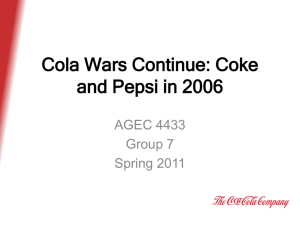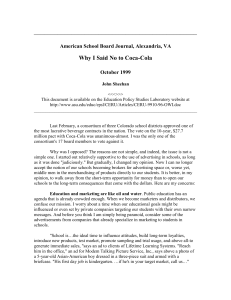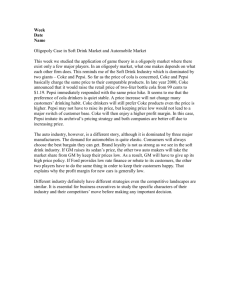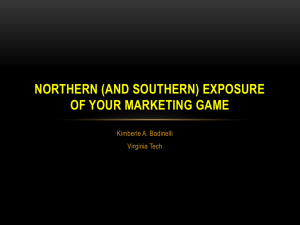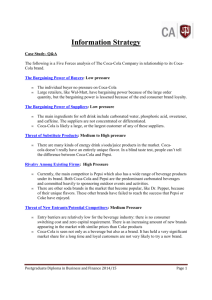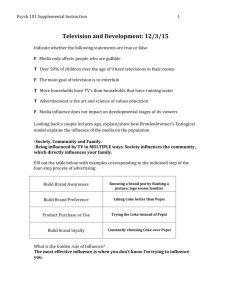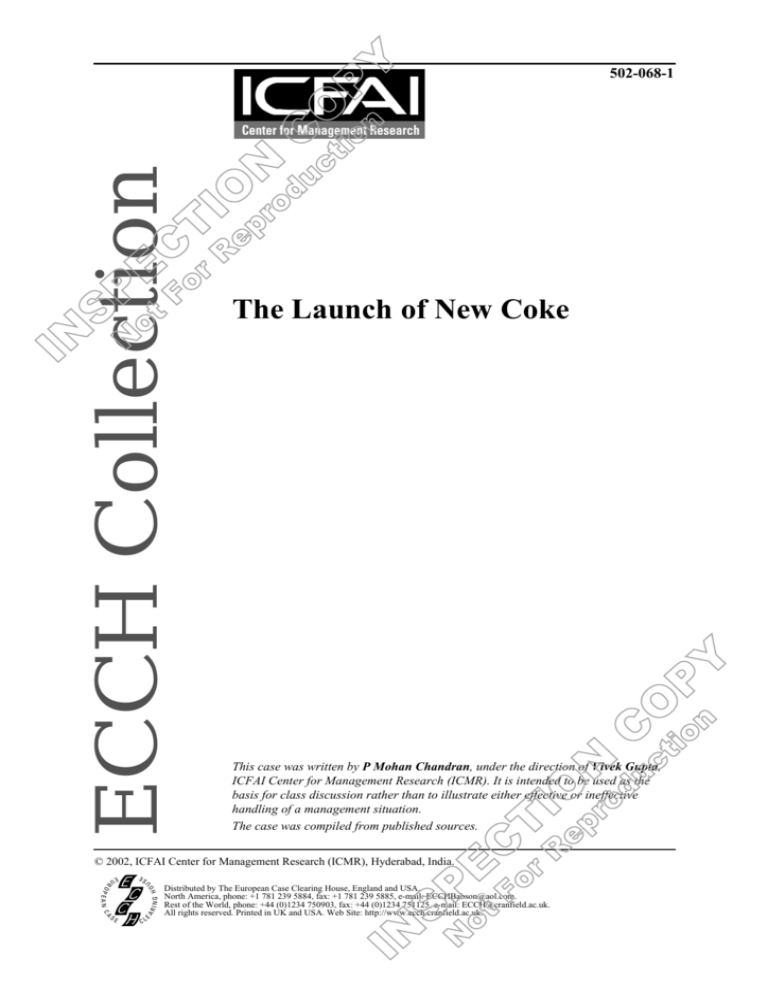
ECCH Collection
502-068-1
The Launch of New Coke
This case was written by P Mohan Chandran, under the direction of Vivek Gupta,
ICFAI Center for Management Research (ICMR). It is intended to be used as the
basis for class discussion rather than to illustrate either effective or ineffective
handling of a management situation.
The case was compiled from published sources.
© 2002, ICFAI Center for Management Research (ICMR), Hyderabad, India.
EA
EU
PEAN CA
RING HOU
SE
RO
SE
CL
Distributed by The European Case Clearing House, England and USA.
North America, phone: +1 781 239 5884, fax: +1 781 239 5885, e-mail: ECCHBabson@aol.com.
Rest of the World, phone: +44 (0)1234 750903, fax: +44 (0)1234 751125, e-mail: ECCH@cranfield.ac.uk.
All rights reserved. Printed in UK and USA. Web Site: http://www.ecch.cranfield.ac.uk.
502-068-1
THE LAUNCH OF NEW COKE
“We set out to change the dynamics of sugar colas in the US, and we did exactly that - albeit not
in the way we had planned.”
- Roberto Goizueta, Chairman & President, Coke, after the ‘New Coke’ fiasco.
INTRODUCTION
On April 23, 1985, Coca-Cola, the largest aerated beverage manufacturer of the world, launched
a sweeter version of the soft drink named ‘New Coke,’ withdrawing its traditional 99 years old
formula. New Coke was launched with a lot of fanfare and was widely publicized through the
television and newspapers. Coca-Cola’s decision to change Coke’s formulation was one of the
most significant developments in the soft drink industry during that time.
Though the initial market response to New Coke was satisfactory, things soon went against CocaCola. Most people who liked the original Coke criticized Coca-Cola’s decision to change its
formula. They had realized that the taste of New Coke was similar to that of Pepsi, Coca-Cola’s
closest competitor, and was too poor when compared to the taste of the original Coke. Analysts
felt that Coca-Cola had failed to understand the emotional attachment of consumers with Coke the brand. They felt that Coca-Cola had lost customer goodwill by replacing a popular product by
a new one that disappointed the consumers.
As a result of consumer protests to New Coke and a significant decline in its sales, Coca-Cola
was forced to revert back to its original formula ten weeks later by launching ‘Coke Classic’ on
July 11, 1985. Roger Enrico, the then CEO of Pepsi commented on the re-introduction of Old
Coke in these words: “I think, by the end of their Coca-Cola nightmare, they figured out who
they really are. They can’t change the taste of their flagship brand. They can’t change its
imagery. All they can do is defend the heritage they nearly abandoned in 1985.” By 1986, New
Coke had a market share of less than 3%.
BACKGROUND NOTE
Dr. John Pemberton, an Atlanta-based pharmacist, developed Coke’s original formula in 1886. It
was based on a combination of oils, extracts from coca leaves (cola nut) and various other
additives including caffeine. These ingredients were refined to create a refreshing carbonated
soda. Pemberton’s bookkeeper, Frank Robinson, suggested that the product be named Coca-Cola.
He also developed the lettering for the brand name in a distinctive flowing script. On May 8,
1886, Coke was released in the market. It was first sold by Joe Jacobs Drug Store in the U.S. The
first advertisement of Coke appeared in ‘The Atlanta Journal’ dated May 29, 1886. Pemberton
took the help of several investors and spent $76.96 on advertising. Initially, he could sell only 50
gallons of syrup at $1 per gallon. To make the drink popular, it was served free for several days –
only after this that the drink gained people’s acceptance.
After Pemberton’s death in 1888, Asa Candler, his friend and a wholesaler druggist, acquired a
stake in the company. Coca-Cola’s sales soared even without much advertising and as many as
61,000 servings (8 ounces) were sold in 1889. This made Candler realize that the business was
profitable. He decided to wind up his drug business and be associated with Coca-Cola full time.
As the business expanded, Candler also invested a higher sum in advertising the drink. By 1891,
Candler bought the company for $2,300. In 1892, he renamed it as Coca-Cola and a year later,
Coca-Cola was registered as a trademark. Only Candler and his associate Robinson knew the
original formula. It was then passed on by word of mouth and became the ‘most closely guarded
secret in the American industry.’ Though occasional rumors spread that cocaine was an
ingredient of Coke’s formula, authorities mentioned that this was not true.
2
502-068-1
By 1895, Coke was made available in all parts of the US, primarily through distributors and
fountain owners. Coke was advertised as a drink, which relieved one of mental and physical
exhaustion, and cured headache. Later, Candler and Robinson repositioned Coke as a refreshment
drink.
In the beginning of the 20th century, manufacturing firms in the US were criticized for promoting
adulterated products and resorting to misleading advertisements. Coca-Cola was an easy target
for such criticisms. The US government passed the Pure Food and Drugs Act in June 1906. A
case was registered against Coca-Cola and the trial began in March 1911. Eventually, Coca-Cola
won the case. But the decision was reversed in the Supreme Court. Finally, the case was settled
outside the court in 1917 with Coca-Cola agreeing to reduce the caffeine content of the drink by
50%.
In 1919, the company was sold to an investment group headed by Ernest Woodruff for $25
million – $10 million in cash and $15 million in preferred stock. Woodruff’s major decision after
taking over the company was to establish a Foreign Department to make Coke popular overseas.
When Coke was released in foreign markets, several problems came up. Initially, it had to rely on
local bottlers who did not promote the product with sufficient enthusiasm, or on wealthy
entrepreneurs, not familiar with the beverage business. The company also faced problems
regarding government regulations, trademark registration, languages and culture.
By 1927, Coca-Cola’s sales rose to nearly 23 million gallons. Even though Pepsi Cola emerged
as its major competitor in the 1930s, Coca-Cola continued doing well. By the time the US took
part in World War II, Coca-Cola was more than 50 years old and well established. In 1962, Paul
Austin (Austin) became Coca-Cola’s tenth president and four years later, he became the chairman
and CEO of the company. By 1965, soft drink sales in the US had risen to 200 drinks per capita,
and Coca-Cola’s market share had risen to 41% against Pepsi’s 24%. In 1964, Coca-Cola also
acquired a coffee business. The company developed drinks with new flavors and also targeted
food chains, which were fast gaining popularity.
In 1970, Coca-Cola faced tough competition from Pepsi. During that year, Pepsi’s advertising
budget exceeded Coca-Cola’s. During the next few years there was a decline in Coca-Cola’s
market share due to Pepsi’s rising sales. In 1978, Pepsi was found to have beaten Coca-Cola in
supermarket sales because of its dominance in vending machines and fountain outlets.
Coca-Cola’s sales continued to decline during the late 1970s, as Austin began new ventures such
as shrimp farming, water projects and viniculture. The political and social unrest in countries like
Iran, Nicaragua and Guatemala had a severe impact on Coca-Cola’s market share. The
company’s poor performance and the increasing discontent of its employees led to Austin’s exit
and the entry of Roberto Goizueta (Goizueta), a 48-year-old chemical engineer, as the company’s
new CEO in 1980.
THE RATIONALE
Soon after becoming CEO, Goizueta concluded that the obsession about increasing the market
share was futile for Coca-Cola and in certain businesses, the return on capital employed (ROCE)
was actually less than the cost of capital. As a result, he sold Coca-Cola’s non-performing
businesses such as wine, coffee, tea, industrial water treatment and aquaculture.
Even after this, Goizueta’s ‘focus strategy’ could not stop the decline in Coca-Cola’s market
share, which fell from 24.3% in 1980 to 21.8% in 1984 – a loss of 2.5% in four years. The
decline in each percentage point amounted to a loss of about $200 million for the company. All
this happened in spite of the fact that Coca-Cola’s annual advertising budget in the early 1980s
3
502-068-1
was higher than Pepsi’s by an average of $100 million. Despite this, Coca-Cola’s advertisements
were not as effective as those of Pepsi were. Pepsi ads showed that even few Coke drinkers
preferred Pepsi in blind taste tests1.
Coca-Cola’s market share continued to decline though it had more vending machines, occupied
more shelf space and was competitively priced against Pepsi. Coca-Cola’s distribution was wider
than Pepsi, which had enabled it to be the leader in the soft drinks industry. It was extremely
popular because of its distinctive taste. By 1984, Coca-Cola’s overall market share had dropped
from 9.8% in the early 1970s to 4.9%. This became a major cause of worry for the top
management of Coca-Cola. During the middle of 1983, the idea of reformulating 99-year old
Coke formula struck Goizueta. The purpose was to increase Coca-Cola’s market share as well as
to defend its position as the market leader.
A thorough market research was conducted which included interviews with about 2,00,000
consumers. This involved an expenditure of $4 million over two years. The results indicated that
consumers who were very fond of Coke constituted 10-12% of the total number of soft drink
consumers. When asked for their reactions to the change in Coke’s taste, half of 10-12% loyal
Coke consumers said that they may oppose change initially, but would eventually accept it, while
the other half said that they would never accept any change.
In some cases, the response was contradictory. For instance, some of the consumers, who had
said that they prefer Coke to Pepsi, were found to be drinking Pepsi most of the times. Others
said Coke was their favorite drink but they drank even Pepsi, or any other drink, which were
available at that time. It was discovered that many people preferred Pepsi to Coke because Pepsi
was sweeter. Coca-Cola felt that the sweeter taste would appeal more to teenagers and youth.
Hence, it decided to launch a sweeter version of Coke, the taste of which would be similar to
Pepsi.
Coca-Cola also conducted a Focus group research2 that revealed that many people were willing to
try New Coke. However, some believed that Coca-Cola should not alter the taste of the drink.
Although both the surveys (Focus group and Survey research) indicated consumer dissatisfaction,
their results were contradictory to each other. While the survey result indicated that such
dissatisfaction was limited only to a small segment of the market, the focus group research
observed a wider dissatisfaction.
In September 1984, Coca-Cola introduced a new drink that tasted better than Pepsi and scored 6
to 8 points3 in blind taste tests. The original Coke already exceeded Pepsi’s popularity by 10
points. The launch of a sweeter version of Coke was expected to make Coke popular than Pepsi
1
Blind taste test is a type of market test where the taste of any product (food products, soft drinks, etc.) is
tested by few persons who are not revealed about the brand name of the product tested. They have to
comment about the taste, sweetness, etc. after having tasted the product and rate it on a paper according to
some parameters like aroma, quality, taste, flavor, color, etc. Later, the brand that scores the highest in
terms of ratings among those tested, is identified and picked. That particular brand is considered to be
superior to other brands tested.
2
A focus group research is conducted and regulated by a skilled moderator. A focus group consists of 6 to
10 people who discuss and thoroughly analyze a particular product, service, organization or any other
marketing aspect for a certain period of time. The participants are also served refreshments and paid a
small amount of money. Through these focus group researches, the hidden feelings of consumers are
sought. Such discussions are focused and they are recorded to study and understand the consumer behavior,
attitudes, perceptions, etc. in the future.
3
The points are given based on factors including taste, sweetness, flavor, color etc., which are used to
judge the product in the blind taste tests. The product/brand that scores the highest points is considered the
best performer and superior to its competitors.
4
502-068-1
by approximately 16 to 18 points. Though the market research had shown customer
dissatisfaction, Coca-Cola ignored it and decided to launch New Coke based on the results of the
blind taste tests.
THE LAUNCH AND ITS AFTERMATH
Coca-Cola launched New Coke in April 1985 with the punch line ‘Catch the wave.’ This change
in Coke’s formula was publicized through the television and newspapers. The company said that
the introduction of New Coke conformed to its efforts to be innovative in its marketing strategies
and establish good customer relationships. The announcement reached more than 80% of the
American population within twenty-four hours.
The launch of New Coke elicited mixed reactions from the public. The initial response to the
product was encouraging with distributors reporting a fairly wide acceptance of it. According to
the analysts, the reason for this was that consumers had not tasted the product yet, and were thus
curious about its taste. The distributors stocked the product in large quantities due to such an
encouraging consumer response. However, the consumers realized that the taste of New Coke
was similar to Pepsi’s and worse when compared to the taste of the original Coke. Gradually,
distributors began to accept less stocks of New Coke and later on, they did not stock any due to
poor consumer response to the drink.
A majority of original Coke lovers criticized the company’s act of changing its formula (Refer
Exhibit I). Many of them stored large stocks of original Coke at home. Consumers perceived
New Coke as a ‘me-too product’4 with a sweeter taste like Pepsi. Some said that the original
Coke had a unique taste that was stronger than New Coke. Some consumers reportedly
complained that the taste of New Coke was similar to sewer water, furniture polish or two dayold Pepsi. An old Coke lover said that the company had spoiled the taste of its 99 year-old soft
drink and betrayed the nation’s trust. Meanwhile, black marketers made a killing as they sold
original Coke at an exorbitant price of $30 per six-and-a-half ounce bottle. Some of them even
tried to import old Coke from abroad. By the end of May 1985, the scenario had worsened with
consumer response at its lowest.
After the launch of New Coke, Coca-Cola received more than a thousand calls per week from the
Coke drinkers, most of whom informed the company that they were planning to substitute Coke
with Pepsi since they found no difference between the two. Coca-Cola had received more than
six thousand calls and around forty thousand letters from Coke loyalists from the US and abroad
all complaining about New Coke after six weeks of its launch.
Due to the protests from a huge number of consumers and a significant decline in the market
share from 15% at the time of the launch to 1.4%, Coca-Cola was forced to revert back to its
original formula ten weeks later, by launching ‘Coke Classic’ on 11th July, 1985. By the end of
1985, Pepsi had more market share than the combined market shares of New Coke and Coke
Classic.
However, in early 1986, Coke again became more popular than Pepsi as the sales of Coke Classic
picked up. By early 1986, New Coke had a market share of less than 3% which came down to
0.6% in 1987 and further down to 0.1% in the late 1980s. Coca-Cola later re-launched New Coke
as ‘Coke II’ in 1990 (Refer to Exhibit IV) which soon phased out due to its unpopularity.
4
A ‘me-too’ product exists with innumerable other products in the market that are similar, thereby
providing only a larger variety and choice to consumers, but no added value in terms of taste, quality,
differentiation or price.
5
502-068-1
NEW COKE – WHAT WENT WRONG?
Analysts attributed the failure of New Coke due to several factors. Some felt that Coca-Cola had
failed to understand the consumers’ emotional attachment with Coke. Reportedly, their
attachment with the brand was so strong that one of them went to the extent of wishing his bones
and ashes to be preserved in Coke cans after his death. But, after the launch of New Coke, he said
that he did not want to be associated with Coca-Cola anymore. Another consumer said that God
and Coke were the only two important things in his life.
Analysts felt that people had a high regard for Coca-Cola because of its innovative ideas,
excellent products launched and the importance it accorded to people and the environment.
During the 1970s, one out of every two cola drinks and one out of every three soft drinks was
Coke. It was made available in more than 140 countries to 5.8 million people. These statistics
proved its popularity. Also, Coca-Cola was the pioneer in recycling plastic bottles. Analysts felt
that Coca-Cola was losing the goodwill of its consumers by launching a product that went against
their preferences, taste and opinion.
Some analysts also felt that the findings of the market research group were erroneous and late.
The research was either in an inappropriate manner or was interpreted incorrectly. Coca-Cola
failed to understand that there was much more to marketing soft drinks than winning taste tests.
According to the analysts, the research could not have measured the type of consumer feelings
that were evoked from reformulation.
Market researchers also felt that Coca-Cola must have gone for focus group testing of a new
product concept first and then used individual interviews to verify and quantify the results of
focus groups. But, in reality, Coca-Cola carried out individual interviews first and then undertook
the focus group testing.
Though the company knew that 10-12% of its loyal customers would not appreciate the change in
its formula, it totally misinterpreted consumers’ response regarding taste. The company was
totally unprepared for unseen possibilities and this caused its market share to decline rapidly after
the introduction of New Coke.
A MARKETING BLUNDER OR A PLOY?
Notwithstanding the negative consumers’ response, some media reports claimed that Coca-Cola’s
act of launching New Coke was actually a deliberate marketing ploy to make people develop a
stronger liking of original Coke after they tasted a low quality version of the drink.
Coca-Cola used cane sugar and corn syrup for the sweet taste of New Coke. During early 1985,
Coca-Cola ran short of cane sugar stocks, but had sufficient stocks of corn syrup. Cane sugar was
sweeter and more expensive than corn syrup. When New Coke was introduced in the market,
people did not like its sweet taste. Such customer response helped Coca-Cola, and only corn
syrup was used while manufacturing Coke Classic. People were so eager to see the original Coke
come back that they did not notice the difference between the sweetness of cane sugar and that of
corn syrup because they were very similar. Coca-Cola thus saved millions of dollars by using
corn syrup rather than cane sugar in its soft drinks.
Another report said that the company never believed that New Coke would be accepted by the
consumers. They deliberately introduced it with an inferior taste. When people got a taste which
they disliked they would demand for the original taste and when the original taste was introduced
they would purchase it in large quantities. This would help Coca-Cola to regain a part of its lost
market share from Pepsi.
6
502-068-1
Though these media reports remain unconfirmed, there was jubilation among the Coke lovers
around the world after the introduction of Coke Classic. Coca-Cola received between 18,000 to
30,000 calls of thanks from every corner of the world. One of them said that it was like “an old
friend had returned home after a long time.”
The New Coke fiasco did not result into losses for Coca-Cola. The sales of Classic Coke went up
to 10 times as that of New Coke soon after its launch. Coca-Cola’s stock price jumped from
$61.875 to $84.500, a 35% increase. By early 1986, the stock hit an all-time high of $110 (Refer
Exhibit II) in 12 years, between 1974 and 1986. At the end of the whole episode, Goizueta was
happy man since it resulted in building shareholders’ value. He said, “But the most significant
result of ‘New Coke’ by far, was that it sent an incredibly powerful signal..... a signal that we
really were ready to do whatever was necessary to build value for the owners of our business.”
Goizueta was rewarded with $1.7 million in salary and bonuses and almost $5 million additional
bonus for the increase in stock price.
QUESTIONS FOR DISCUSSION:
1. The launch of New Coke turned out to be a nightmare for Coca-Cola. Discuss the marketing
implications of introducing New Coke. Was it necessary to re-formulate New Coke?
2. Market researchers had expected Coca-Cola to conduct focus group testing of a new product
first and then use individual interviews to verify the results of the focus groups. What other
types of research methods would have been helpful to the company in providing consumer
insights? Discuss.
3. Though some analysts felt that the launch of New Coke was a blunder, others thought it was
a deliberate marketing ploy. Is the failure of New Coke really a marketing blunder? Give
your opinion and substantiate it.
7
502-068-1
EXHIBIT I
REACTIONS AFTER THE LAUNCH OF “NEW COKE”
CONSUMERS’ REACTIONS
Consumers were annoyed about the change in the taste of Coke. They reacted strongly to
such a change. One of them said that Coca-Cola’s act of changing Coke’s taste was like
God’s making the grass purple, or putting the toes on the ears, or the teeth on the knees.
Someone else said that he considered Coke as the greatest thing after God in this world. He
felt as if one of those things has been taken away from him when he heard that Coke had
withdrawn the old product and introduced a new one. Another Coke loyalist said he did not
want to associate himself with Coke anymore because of Coca-Cola’s decision to change
its taste. Many consumers switched over to Pepsi.
Most of the consumers also criticized the taste of New Coke in comparison with old. They
said it tasted like stale Pepsi. One Coke loyalist felt that the taste of the 99 year-old was
spoiled and this had instilled a feeling of distrust and betrayal among the consumers in the
US. One of the soft drink drinkers said that he felt like spitting New Coke on the American
flag. Another said that he wouldn’t have felt bad if he came to know that he was a gay, but
the change in the old formula has really hurt him. Another one said that, when he learnt
about the change in Coke’s taste, he turned numb, he was shocked and he wanted to shout
at the top of his voice. One of the consumers remarked that the withdrawal of old Coke was
like violating a person’s freedom of choice. The consumer was deprived from choosing a
product based on personal preferences.
EXECUTIVES’ OPINION
One of the passionate lovers of Coke - a retired airforce officer - said that he wanted his
bones to be preserved in a Coke can after his death. A 35 year-old vice president of an
insurance company remarked that New Coke was too sweet and tasted like Pepsi to some
extent. She also said that New Coke was not as strong as the regular Coke.
COMPETITOR’S OPINION
When Pepsi learnt about the change in Coke’s formula, it remarked that this was their
victory over Coca-Cola as Coca-Cola had officially accepted that Pepsi tasted better than
Coke. The President and CEO of Pepsi, Roger Enrico said that the withdrawal of original
Coke from the market and the launch of New Coke was a clear indication of the victory of
Pepsi over Coca-Cola. He said that Coca-Cola had to change its formula only because it
was envious of the Pepsi’s growth in terms of market share as well as sales.
MARKETER’S VIEW
A Coke marketer said that the introduction of New Coke made him feel as if a cure for
cancer had been invented.
Source: www.planetpapers.com, www.antiessays.bigwonk.com & www.toptown.com
8
502-068-1
EXHIBIT II
STOCK PRICE MOVEMENT OF COCA-COLA’S SHARE
Date
March 30, 1984
March 31, 1986
March 31, 1987
March 31, 1988
March 31, 1989
March 31, 1992
March 31, 1993
Actual Stock Price
$54.87
$105.25
$45.75
$38.25
$51.25
$81.75
$42.62
Volume of shares traded
6,180,000
4,720,800
6,129,600
4,691,200
3,436,000
3,058,800
3,161,800
Source: www.coca-cola.com
EXHIBIT III
GLOBAL MARKET SHARE OF COCA-COLA AND PEPSI (2001)
Coca-Cola’s global market share for the year ended 2001 was 44% compared to Pepsi’s 32%.
The following are the top ten brands for 2001 and their respective market shares:
Top Brands
Market Shares
Coke Classic
19.90%
Pepsi Cola
13.20%
Diet Coke
8.80%
Mountain Dew
6.90%
Sprite
6.50%
Dr. Pepper
6.20%
Diet Pepsi
5.30%
7-Up
1.90%
Caffeine Free Diet Coke
1.70%
Barq’s Root Beer
1.10%
Source: pub19.ezboard.com
9
502-068-1
EXHIBIT IV
NEW COKE RE-LAUNCHED AS “COKE II”
Source: www.prairienet.org/popcan
COKE CLASSIC INTRODUCED IN CANS
Source: www.sodapop.com
10


